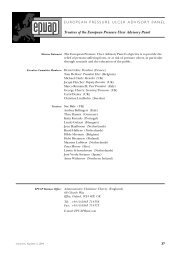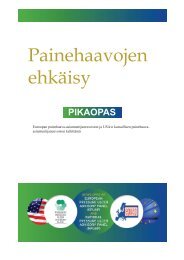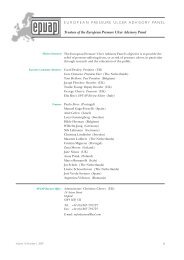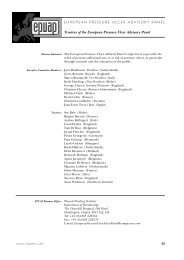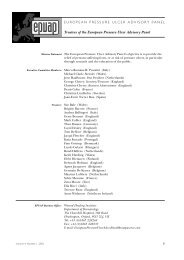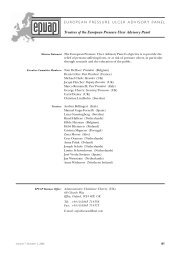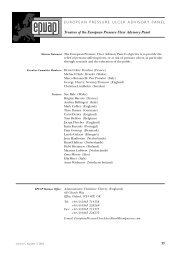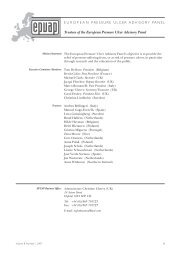SCALE Final Consensus Statement - European Pressure Ulcer ...
SCALE Final Consensus Statement - European Pressure Ulcer ...
SCALE Final Consensus Statement - European Pressure Ulcer ...
Create successful ePaper yourself
Turn your PDF publications into a flip-book with our unique Google optimized e-Paper software.
• Diminished tissue perfusion, impaired skin<br />
oxygenation, decreased local skin temperature,<br />
mottled discoloration, and skin necrosis.<br />
• Loss of skin integrity from any of a number<br />
of factors including equipment or devices,<br />
incontinence, chemical irritants, chronic<br />
exposure to body fluids, skin tears, pressure,<br />
shear, friction, and infections.<br />
• Impaired immune function.<br />
Diminished tissue perfusion is the most significant<br />
risk factors for <strong>SCALE</strong> and generally occurs in areas<br />
of the body with end arteries, such as the fingers,<br />
toes, ears, and nose. These areas may exhibit early<br />
signs of vascular compromise and ultimate collapse,<br />
such as dusky erythema, mottled discoloration, local<br />
cooling, and eventually infarcts and gangrene.<br />
As the body faces a critical illness or disease state, a<br />
normal protective function may be to shunt a larger<br />
percentage of cardiac output from the skin to more<br />
vital internal organs, thus averting immediate death.<br />
Chronic shunting of blood to the vital organs may<br />
also occur as a result of limited fluid intake over a<br />
long period of time. Most of the skin has collateral<br />
vascular supply but distal locations such as the<br />
fingers, toes, ears and nose have a single vascular<br />
route and are more susceptible to a critical decrease<br />
in tissue oxygenation due to vasoconstriction.<br />
Furthermore, the ability to tolerate pressure is<br />
limited in poorly perfused body areas.<br />
Additional literature reviews and clinical research<br />
are needed to more thoroughly comprehend and<br />
document all of the potential risk factors associated<br />
with <strong>SCALE</strong> and their clinical manifestations.<br />
For pressure ulcers, it is important<br />
to determine if the ulcer may be (i)<br />
healable within an individual’s life<br />
expectancy, (ii) maintained, or (iii)<br />
non-healable or palliative.<br />
<strong>Statement</strong> 7<br />
A total skin assessment should be performed<br />
regularly and document all areas of concern<br />
consistent with the wishes and condition of the<br />
patient. Pay special attention to bony prominences<br />
and skin areas with underlying cartilage. Areas of<br />
special concern include the sacrum, coccyx, ischial<br />
tuberosities, trochanters, scapulae, occiput, heels,<br />
digits, nose and ears. Describe the skin or wound<br />
abnormality exactly as assessed.<br />
It is important to assess the whole body because<br />
there may be signs that relate to skin compromise.<br />
Table 1 provides a limited list of dermatologic terms<br />
that may be useful when describing areas of concern.<br />
Table 2 provides descriptive terms for lesions based<br />
on characteristics and size.<br />
<strong>Statement</strong> 8<br />
Consultation with a qualified health care<br />
professional is recommended for any skin changes<br />
associated with increased pain, signs of infection,<br />
skin breakdown (when the goal may be healing),<br />
and whenever the patient’s circle of care expresses<br />
a significant concern.<br />
There are very definite descriptive terms for skin<br />
changes that can be used to facilitate communication<br />
between health care professionals (see <strong>Statement</strong><br />
7). Until more is known about <strong>SCALE</strong>, subjective<br />
symptoms need to be reported and objective skin<br />
changes described. This will allow for identification<br />
and characterization of potential end of life skin<br />
changes.<br />
An accurate diagnosis can lead to decisions about<br />
the area of concern and whether it is related to end<br />
of life care and/or other factors. The diagnosis will<br />
help determine appropriate treatment and establish<br />
realistic outcomes for skin changes. For pressure<br />
ulcers, it is important to determine if the ulcer may<br />
be (i) healable within an individual’s life expectancy,<br />
(ii) maintained, or (iii) non-healable or palliative. 17<br />
The treatment plan will depend on an accurate<br />
diagnosis, the individual’s life expectancy and wishes,<br />
family members’ expectations, institutional policies,<br />
<strong>SCALE</strong> <strong>Final</strong> <strong>Consensus</strong> <strong>Statement</strong>, October 1, 2009 Page 9



